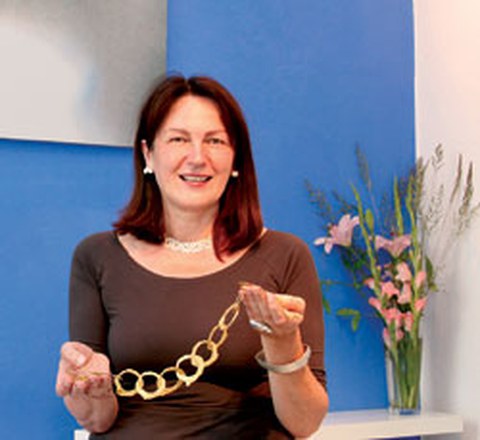A former construction site manager with the heart of an artist
(Interview from 2009)
Dagmar Möbius
Marion Bogda studied technical facilities management and specialized in heating, ventilation, and plumbing. After many years as a project engineer and site manager, she set up her own business – as a jewelry gallery owner.

Marion Bogda
"Gold cannot save a bad idea, but it doesn't harm a good one." I did not ask Marion Bogda whether this also applies to faucets. She would probably smile and reply with a wink that gold faucets might well count as contemporary jewelry. One thing is for sure, namely that the technical facilities management engineer agrees one hundred percent with the quote above from designer Kay Eppi Nölke. And Marion Bogda must be right – she knows her way around both construction and art.
The Dresden native began her career path with vocational training as a machine and system fitter plus high school diploma (Abitur). Her degree in technical facilities management at TU Dresden from 1976 to 1980, majoring in Mechanical Engineering, was a logical next step. "The requirements weren't that high," she says, but admits that her "heart wasn't really in it." With a top grade of 1.1 in her Abitur, she would have preferred to study law. "Still, it was special to go to TUD, while many of my classmates had to move far afield to study mechanical engineering at universities of applied science."
Marion Bogda devoted the years following her graduation to raising her children. At home. "That wasn't the norm in GDR times, but it was important to me," she says. Until reunification, which triggered a major construction boom. "I had to completely reorient myself, learn about standards, and acquire CAD skills, but I quickly found a job working on projects for an engineering firm in Dresden." For the office manager from Cologne, this was a stroke of luck. He wanted to hire "someone with intellect who wasn’t hung up on outdated standards." Starting a career was nonetheless difficult. "I had to relearn everything because I could remember almost nothing of what I had heard at university." That was not entirely true, for she still had her knowledge of materials, her understanding of processing methods, and the math skills for profitability and other calculations. "We always had to work out the practical side ourselves anyway." She spent three years learning the ropes of heating technology. One of her projects was planning the site road at Bad Salzungen power plant. "I hope it's still functional today," she says, laughing. "What a hassle I had with truck turning radius calculations!"
When a friend opened an office-sharing space for young people from various construction trades, Marion Bogda was on board. She managed the local branch for three years. After the office was closed, she worked for seven years as a project engineer and site manager for an engineering firm, most recently, incidentally, at the office of the TU University Executive Board on Mommsenstraße. She enjoyed this work very much. "Particularly the aspect of dealing with a wide variety of people, from construction workers to developers." Years of working with architects honed her eye for design, fittings and furnishings, color, and shapes.
When there was less and less to do in construction and her children were grown up, Marion Bogda ventured into something completely new. Simply "passing the time" was out of the question for the dynamic engineer. In December 2005, she opened a jewelry gallery on Dresden's Körnerplatz square. A leap into the unknown? Only outsiders might find the change of profession a little unusual: Marion Bogda is the wife of a jewelry designer, and she had long been fascinated by art. She frequently accompanied her husband to trade fairs, and she had learned a lot and made many contacts. A lot of designers offered their encouragement. They believed her fresh, unbiased perspective was an advantage. Marion Bogda now works with around 40 jewelry designers. "To me, jewelry has to make its own, individual statement," is how she describes her standards. This need not necessarily mean luxury. On the contrary: "Jewelry should be wearable and affordable, including and especially for young people."
As each item of jewelry has its own fascinating stories to tell, the titanblau gallery owner regularly hosts gallery opening nights. There, she explains how grass and sticking plaster rings are made, who invented label bracelets, or how to wear rings and earrings. Not to mention how her gallery got its name. She had learned from her husband Gottfried Bogda, who made his name as a jewelry designer with titanium jewelry in particular, that "when titanium is heated, it turns blue." A reference to the nearby "Blaues Wunder" ("Blue Wonder") bridge eventually led to the name "titanblau" ("titanium blue").
The jewelry gallery at the end of Schillerstraße is now known far beyond Dresden as the place to go for something special, and above all for extraordinary wedding rings. For Marion Bogda, a good idea definitely has to do with gold. Figuratively speaking. But maybe also with iron, titanium, steel, plastic, or fabric. Mini-faucets? Possible. A return to the construction site? Unlikely.
Contact details:
Marion Bogda
titanblau – Galerie für Schmuck
Körnerplatz 10
01326 Dresden
Tel.: +49 351 2655310
Email: Marion Bogda
Web: Galerie Titanblau
